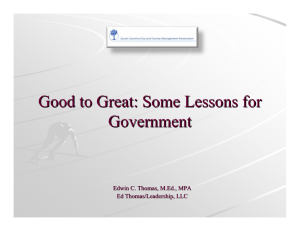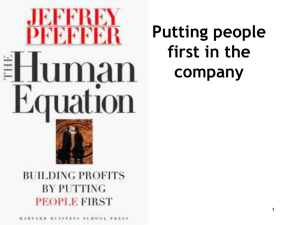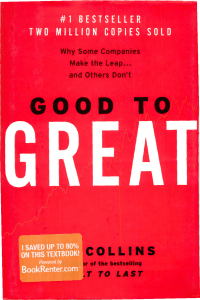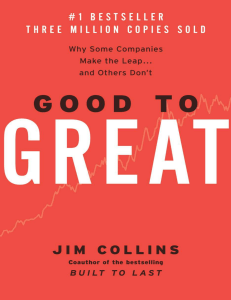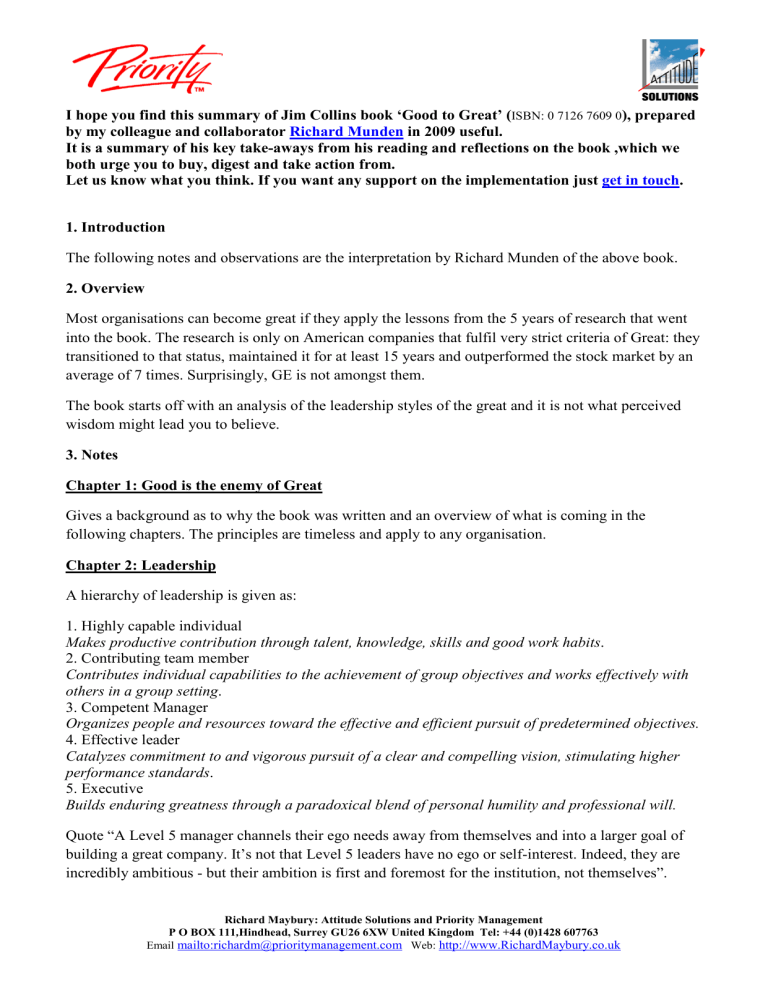
I hope you find this summary of Jim Collins book ‘Good to Great’ (ISBN: 0 7126 7609 0), prepared by my colleague and collaborator Richard Munden in 2009 useful. It is a summary of his key take-aways from his reading and reflections on the book ,which we both urge you to buy, digest and take action from. Let us know what you think. If you want any support on the implementation just get in touch. 1. Introduction The following notes and observations are the interpretation by Richard Munden of the above book. 2. Overview Most organisations can become great if they apply the lessons from the 5 years of research that went into the book. The research is only on American companies that fulfil very strict criteria of Great: they transitioned to that status, maintained it for at least 15 years and outperformed the stock market by an average of 7 times. Surprisingly, GE is not amongst them. The book starts off with an analysis of the leadership styles of the great and it is not what perceived wisdom might lead you to believe. 3. Notes Chapter 1: Good is the enemy of Great Gives a background as to why the book was written and an overview of what is coming in the following chapters. The principles are timeless and apply to any organisation. Chapter 2: Leadership A hierarchy of leadership is given as: 1. Highly capable individual Makes productive contribution through talent, knowledge, skills and good work habits. 2. Contributing team member Contributes individual capabilities to the achievement of group objectives and works effectively with others in a group setting. 3. Competent Manager Organizes people and resources toward the effective and efficient pursuit of predetermined objectives. 4. Effective leader Catalyzes commitment to and vigorous pursuit of a clear and compelling vision, stimulating higher performance standards. 5. Executive Builds enduring greatness through a paradoxical blend of personal humility and professional will. Quote “A Level 5 manager channels their ego needs away from themselves and into a larger goal of building a great company. It’s not that Level 5 leaders have no ego or self-interest. Indeed, they are incredibly ambitious - but their ambition is first and foremost for the institution, not themselves”. Richard Maybury: Attitude Solutions and Priority Management P O BOX 111,Hindhead, Surrey GU26 6XW United Kingdom Tel: +44 (0)1428 607763 Email mailto:richardm@prioritymanagement.com Web: http://www.RichardMaybury.co.uk Key points: • • • • • • • • • Every good-to-great company had Level 5 leadership during the pivotal transition years. “Level 5” refers to the 5-level hierarchy of executive capabilities, with level 5 being at the top. Level 5 leaders display compelling modesty, are self-effacing and understated. They set up their successors for even greater success in the next generation, In contrast, Level 4 leaders with gargantuan personal egos can contribute to the demise or continued mediocrity of the company and often set up their successors for failure. Level 5 leaders are fanatically driven, infected with an incurable need to produce sustained results. They are resolved to do whatever it takes to make the company great. Level 5 leaders display a workmanlike diligence – more plough horse than show horse. Level 5 leaders look out of the window to attribute success to factors other than themselves. When things go poorly, however, they look in the mirror and blame themselves, taking full responsibility. The comparison CEOs often did just the opposite – they looked in the mirror to take the credit for success, but out of the window to assign blame for disappointing results. One of the most damaging trends in recent history is the tendency (especially by boards of directors) to select dazzling, celebrity leaders and to de-select potential Level 5 leaders. I believe that potential Level 5 leaders exist all around us, if we just know what to look for. Chapter 3: First who…..then what The chapter puts up 2 models of leadership: Level 5 and the Genius with a thousand helpers. These are described in the following key points: • • • • • The Level 5 leader began the transformation by first getting the right people on the bus (and the wrong people off the bus) and then figured out where to drive it. The key point of this chapter is not just the idea of getting the right people on the team. The key point is that “who” questions came before “what” decisions – before vision, before strategy, before structure, before tactics – as a rigorous discipline, consistently applied. The comparison companies frequently followed the “genius with a thousand helpers” model – a genius leader who sets a vision then enlists a crew of highly capable “helpers” to make it happen. This model fails when the genius departs. The good-to-great leaders were rigorous, not ruthless, in people decisions. They did not rely on layoffs and restructuring as a primary strategy for improving performance. The comparison companies used layoffs to a much greater extent. The research uncovered three practical disciplines for being rigorous in people decisions: 1. When in doubt, do not hire – keep looking (i.e. limit growth based on ability to attract enough of the right people). 2. When you know you need to make a people change, act. Be sure you don’t simply have someone in the wrong job. 3. Put your best people on your biggest opportunities, not your biggest problems. Richard Maybury: Attitude Solutions and Priority Management P O BOX 111,Hindhead, Surrey GU26 6XW United Kingdom Tel: +44 (0)1428 607763 Email mailto:richardm@prioritymanagement.com Web: http://www.RichardMaybury.co.uk • • • • Good-to-Great management teams consist of people who debate vigorously in search of the best answers, yet who unite behind those decisions. No link has been found between executive compensation and the shift from good to great. Compensation should not “motivate” the right behaviours from the wrong people, but get and keep the right people in the first place. Contrary to the old adage, people are not your most important asset, the right people are. Whether someone is the “right person” has more to do with character traits and innate capabilities than with specific knowledge, background or skills. Chapter 4: Confront the brutal facts Key points: • • • • • • • • • All good-to-great companies began the process of finding a path to greatness by confronting the brutal facts of their current reality. Only by honestly and diligently confronting the brutal facts can good decisions be made. A good-to-great company’s culture encourages people, and, ultimately, the truth, to be heard. Creating such a climate involves leading with questions, not answers, engaging in dialogue and debate, not coercion, conducting autopsies without blame and turning information into facts that cannot be ignored. The good to great companies responded differently to adversity by hitting the realities of their situation head-on and therefore emerging even stronger. A key psychology for leading from good to great is the STOCKDALE paradox: Face the current brutal facts but retain absolute faith that you can and will prevail. The strength of your leadership personality (or “charisma”) can deter people from bringing you the brutal facts. Leadership not only begins with vision, but also with getting people to confront the brutal facts and act on the implications. Trying to “motivate” people is a waste of time. The key is not to de-motivate them (for example, by ignoring the brutal facts). Chapter 5: The hedgehog concept This is based on a famous essay “The hedgehog and the fox” by Isaiah Berlin. Key points • To go from good to great requires a deep understanding of three intersecting circles translated into a simple, crystalline concept (the hedgehog concept). Richard Maybury: Attitude Solutions and Priority Management P O BOX 111,Hindhead, Surrey GU26 6XW United Kingdom Tel: +44 (0)1428 607763 Email mailto:richardm@prioritymanagement.com Web: http://www.RichardMaybury.co.uk • • • • • Understanding what your organisation can and cannot be the best in the world at If you cannot be the best in the world at your core business, then your core business cannot be based on the hedgehog concept. The “best in the world” understanding means you might have a core competence but not the current capacity or, conversely, you do not have the current competence. Within your economic engine, search for the one denominator that has the single greatest impact. Good to great companies set their goals and strategies based on this understanding, rather than on bravado. Unexpected Findings: • • • • The good to great companies resemble hedgehogs - simple, dowdy creatures that know “one big thing” and stick to it. Comparison companies resemble foxes – crafty, cunning creatures that know many things but lack consistency. It took four years on average for the good to great companies to get a hedgehog concept. Both the good to great and the comparison companies spent equal time on strategic planning. You do not need to be in a great industry to produce sustainable results. Good to great companies can produce superior economic returns in a bad industry. Chapter 6: Culture of Discipline Key points • • • Sustained great results depend upon building a culture full of self-disciplined people, consistent with the three circles in the hedgehog concept. Stultifying bureaucratic cultures arise to compensate for incompetence and lack of discipline (having the wrong people on the bus). A culture of discipline involves duality – having people adhere to the consistent system and yet giving freedom and responsibility within the framework of it. Richard Maybury: Attitude Solutions and Priority Management P O BOX 111,Hindhead, Surrey GU26 6XW United Kingdom Tel: +44 (0)1428 607763 Email mailto:richardm@prioritymanagement.com Web: http://www.RichardMaybury.co.uk • • • • A culture of discipline is about getting disciplined people who engage in disciplined thought and who then take disciplined action. The good to great companies can appear boring and pedestrian looking, but in fact they have people who display extreme diligence and a stunning intensity (“they rinse their cottage cheese”). Do not confuse a culture of discipline (highly functional) with a tyrant who disciplines (highly dysfunctional). The single most important form of discipline for sustained results is fanatical adherence to the hedgehog concept and to not fall outside the three circles. Unexpected findings • • • • The more an organization has the discipline to consistently stay within its three circles, the more it will have opportunities for growth. A great company can have many “once in a lifetime opportunities”, but it only runs with one that fits within the three circles. The purpose of budgeting in a good company is to decide which arenas best fit with the Hedgehog concept and to fully fund only them. “Stop doing” lists are more important than “to do” lists. Chapter 7: Technology acceleration Key points: • • • • • • Great organisations think differently about technology and technological change than mediocre ones. Good-to-great organisations avoid technology fads and bandwagons, but become pioneers in the application of carefully selected technologies The key question to any technology is: does it fit directly with your hedgehog concept? If yes, then become a pioneer of its application. If no, then settle for parity or ignore it entirely. The good to great companies used technology as an accelerator of momentum, not a creator of it. They didn’t begin their transformations with pioneering technology; they first grasped how to fit it within their three circles, hit breakthrough and then became pioneers. The good-to-great companies’ competitors could have taken the same leading-edge technologies to pioneer for free and failed to produce anywhere near the same results. Great companies react to technological change with thoughtfulness and creativity, driven to turning unrealized potential into results, and have an inner drive for greatness versus mediocrity. Mediocre companies react and lurch about, motivated by fear of being left behind. Richard Maybury: Attitude Solutions and Priority Management P O BOX 111,Hindhead, Surrey GU26 6XW United Kingdom Tel: +44 (0)1428 607763 Email mailto:richardm@prioritymanagement.com Web: http://www.RichardMaybury.co.uk Unexpected findings • The idea that technological change is the principle cause in the decline of once-great companies is not supported by the evidence and technology by itself is never a primary root cause of either greatness or decline. • Across eighty-four interviews with good-to-great executives, fully 80% didn’t even mention technology as one of the top five factors in the transformation. “Crawl, Walk, Run” can be a very effective approach, even during rapid and radical technological change. • Chapter 8: The flywheel and doom loop Key points • • • • • Good-to-great transformations often look like dramatic, revolutionary events to those observing from the outside, but they feel like organic, cumulative processes to people on the inside. Our perception can confuse end outcomes (dramatic results) with process (organic and cumulative). No matter how dramatic the end result, the good-to-great transformations never happened in one fell swoop. Sustainable transformations follow a predictable pattern of build-up and breakthrough. Like pushing on a heavy flywheel, it takes great effort to get the thing moving at all, but persistently pushing in a consistent direction over a long period of time builds momentum and eventually hits breakthrough. The comparison companies followed a different pattern, the doom loop, by trying to skip build up and jump immediately to breakthrough, thereby failing to maintain a consistent direction. Good to great companies used large acquisitions after breakthrough (accelerating momentum in an already fast-spinning flywheel), whereas the comparison companies frequently tried to create a break with large, misguided acquisitions. Unexpected results • • • Those inside the good-to-great companies were often unaware of the magnitude of their transformation at the time; only later, in retrospect, did it become clear. They had no launch event or program to signify what they were doing at the time. Under the right conditions, the problems of commitment, alignment, motivation, and change largely take care of themselves. Alignment principally follows from results and momentum, not the other way around. The flywheel effect is not in conflict with pressures such as, for example, the recent short-term ones of Wall Street. It was the key to managing them. Richard Maybury: Attitude Solutions and Priority Management P O BOX 111,Hindhead, Surrey GU26 6XW United Kingdom Tel: +44 (0)1428 607763 Email mailto:richardm@prioritymanagement.com Web: http://www.RichardMaybury.co.uk
